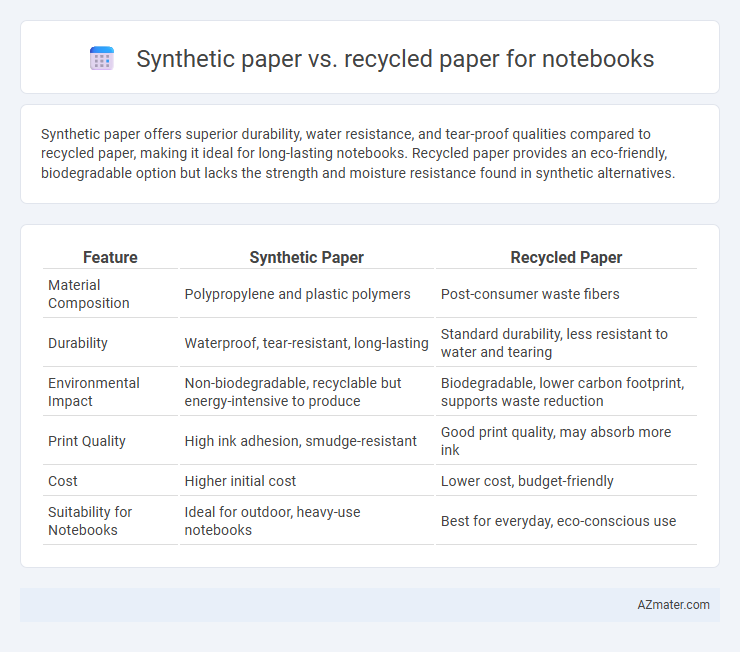Synthetic paper offers superior durability, water resistance, and tear-proof qualities compared to recycled paper, making it ideal for long-lasting notebooks. Recycled paper provides an eco-friendly, biodegradable option but lacks the strength and moisture resistance found in synthetic alternatives.
Table of Comparison
| Feature | Synthetic Paper | Recycled Paper |
|---|---|---|
| Material Composition | Polypropylene and plastic polymers | Post-consumer waste fibers |
| Durability | Waterproof, tear-resistant, long-lasting | Standard durability, less resistant to water and tearing |
| Environmental Impact | Non-biodegradable, recyclable but energy-intensive to produce | Biodegradable, lower carbon footprint, supports waste reduction |
| Print Quality | High ink adhesion, smudge-resistant | Good print quality, may absorb more ink |
| Cost | Higher initial cost | Lower cost, budget-friendly |
| Suitability for Notebooks | Ideal for outdoor, heavy-use notebooks | Best for everyday, eco-conscious use |
Introduction to Synthetic and Recycled Paper
Synthetic paper is made from plastic polymers such as polypropylene, offering durability, water resistance, and tear-proof qualities ideal for notebooks used in harsh environments. Recycled paper is produced from repurposed paper fibers, reducing environmental impact by conserving trees and lowering energy consumption during manufacturing. Both materials serve different sustainability and performance needs within the notebook industry.
What Is Synthetic Paper?
Synthetic paper is a durable, waterproof material made from plastic resins such as polypropylene, offering tear resistance and longevity beyond traditional recycled paper. Recycled paper, derived from post-consumer waste, prioritizes environmental sustainability but often lacks the moisture resistance and strength of synthetic paper. For notebooks, synthetic paper provides smudge-proof, weather-resistant pages ideal for outdoor or heavy-use conditions, while recycled paper appeals to eco-conscious users seeking biodegradable options.
Understanding Recycled Paper
Recycled paper for notebooks is produced from reclaimed fibers, significantly reducing environmental impact by minimizing deforestation and lowering energy consumption during manufacturing. It offers adequate durability and writing quality suitable for everyday use, with the added benefit of promoting sustainable resource management. Understanding recycled paper reveals its role in supporting eco-friendly paper production without compromising functionality in notebooks.
Durability and Longevity Comparison
Synthetic paper offers superior durability and longevity for notebooks compared to recycled paper, resisting water, tearing, and wear under heavy use. Its synthetic fibers maintain structural integrity over time, preventing yellowing and degradation commonly seen in recycled paper products. Recycled paper, while eco-friendly, tends to be less resistant to moisture and physical damage, leading to shorter lifespan in notebooks.
Environmental Impact: Synthetic vs Recycled Paper
Recycled paper for notebooks significantly reduces deforestation by reusing fibers from post-consumer waste, lowering carbon emissions and energy consumption compared to virgin materials. Synthetic paper, made primarily from plastic resins, offers durability and water resistance but poses environmental challenges due to its non-biodegradable nature and reliance on petrochemicals. While synthetic paper's longevity can decrease frequent replacements, its production and disposal impact may offset these benefits compared to the eco-friendly attributes of recycled paper.
Print Quality and Usability
Synthetic paper offers superior print quality for notebooks due to its smooth, non-porous surface, allowing for vibrant, smudge-resistant ink that resists water and fading. Recycled paper tends to have a rougher texture, which can cause ink to bleed or appear dull, affecting the clarity and sharpness of printed images and text. In terms of usability, synthetic paper is more durable, tear-resistant, and suitable for various writing instruments, while recycled paper provides an eco-friendly, cost-effective option but may degrade faster with heavy use.
Water and Tear Resistance
Synthetic paper offers superior water resistance and tear durability compared to recycled paper, making it ideal for notebooks exposed to moisture or rough handling. Unlike recycled paper, synthetic paper is engineered from plastic polymers that create a tough, waterproof surface, maintaining integrity even when wet. Recycled paper, while eco-friendly, tends to absorb water easily and tears more readily, limiting its effectiveness in high-stress or humid environments.
Cost Analysis: Which Is More Economical?
Synthetic paper generally incurs a higher upfront cost due to specialized manufacturing processes and durable materials like polypropylene. Recycled paper offers a more economical option, benefiting from lower raw material expenses and reduced environmental impact, making it ideal for budget-sensitive notebook production. When factoring in longevity and resistance to wear, synthetic paper may justify its cost in premium applications, but recycled paper remains the cost-effective choice for mass-market notebooks.
Best Applications for Each Paper Type
Synthetic paper offers superior durability, water resistance, and tear-proof qualities, making it ideal for notebooks used in outdoor, industrial, or marine environments where exposure to moisture and rough handling is common. Recycled paper is best suited for eco-friendly notebooks intended for everyday writing, note-taking, and educational purposes, as it promotes sustainability while maintaining adequate print quality and affordability. Choosing between synthetic and recycled paper depends primarily on the user's needs for durability versus environmental impact.
Conclusion: Choosing the Right Notebook Paper
Synthetic paper offers superior durability, water resistance, and tear-proof qualities, making it ideal for notebooks used in harsh environments or for long-term preservation. Recycled paper is an eco-friendly option that reduces environmental impact by minimizing waste and saving resources, suitable for everyday note-taking with a focus on sustainability. Selecting the right notebook paper depends on balancing durability needs with environmental considerations to match specific usage scenarios.

Infographic: Synthetic paper vs Recycled paper for Notebook
 azmater.com
azmater.com